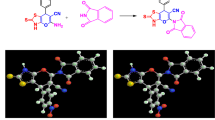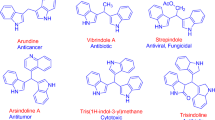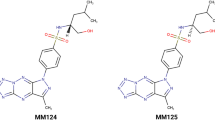Summary
Thiocoraline, a new anticancer agent derived from the marine actinomycete Micromonospora marina, was found to induce profound perturbations of the cell cycle. On both LoVo and SW620 human colon cancer cell lines, thiocoraline caused an arrest in G1 phase of the cell cycle and a decrease in the rate of S phase progression towards G2/M phases, as assessed by using bromodeoxyuridine/DNA biparametric flow cytometric analysis. Thiocoraline does not inhibit DNA-topoisomerase II enzymes in vitro, nor does it induce DNA breakage in cells exposed to effective drug concentrations. The cell cycle effects observed after exposure to thiocoraline appear related to the inhibition of DNA replication. By using a primer extension assay it was found that thiocoraline inhibited DNA elongation by DNA polymerase α at concentrations that inhibited cell cycle progression and clonogenicity. These studies indicate that the new anticancer drug thiocoraline probably acts by inhibiting DNA polymerase α activity.
Similar content being viewed by others
Article PDF
Change history
16 November 2011
This paper was modified 12 months after initial publication to switch to Creative Commons licence terms, as noted at publication
References
Capranico, G., Zunino, F., Kohn, K. W. & Pommier, Y. (1990). Sequence-selective topoisomerase II inhibition by anthracycline derivatives in SV40 DNA: relationship with DNA binding affinity and cytotoxicity. Biochemistry 29: 562–569.
Catapano, C. V., Perrino, F. W. & Fernandes, D. J. (1993). Primer RNA chain termination induced by 9-beta-D-arabinofuranosyl-2-fluoroadenine 5′-triphosphate. A mechanism of DNA synthesis inhibition. J Biol Chem 268: 7179–7185.
Erba, E., Sen, S., Sessa, C., Vikhanskaya, F. L. & D’Incalci, M. (1994). Mechanism of cytotoxicity of 5,10-dideazatetrahydrofolic acid in human ovarian carcinoma cells in vitro and modulation of the drug activity by folic or folinic acid. Br J Cancer 69: 205–211.
Erba, E., Mascellani, E., Pifferi, A. & D’Incalci, M. (1995). Comparison of cell-cycle phase perturbations induced by the DNA-minor-groove alkylator tallimustine and by melphalan in the SW626 cell line. Int J Cancer 62: 170–175.
Faircloth, G., Jimeno, J. & D’Incalci, M. (1997). Biological activity of thiocoraline, a novel marine depsipeptide. Eur J Cancer 33: 175 (Abstract)
Faretta, M., Bergamaschi, D., Taverna, S., Ronzoni, S., Mascellani, E., Cappella, P., Ubezio, P. & Erba, E. (1998). Characterization of cyclin B1 expression in human cancer cell lines by a new three-parameter BrdU/cyclin B1/DNA analysis. Cytometry 31: 53–59.
Huberman, J. A. (1981). New views of the biochemistry of eucaryotic DNA replication revealed by aphidicolin, an unusual inhibitor of DNA polymerase α. Cell 23: 647–648.
Kohn, K. W., Ewing, R. A. G., Erickson, L. C. & Zwelling, L. A. (1981). Measurements of strand breaks and cross-links by alkaline elution. In DNA Repair: a Laboratory Manual of Research Techniques, Frieddberg EC, Hanawalt PC (eds). Marcel Dekker: New York
Krishan, A. & Frei, E III (1976). Effect of adriamycin on the cell cycle traverse and kinetics of cultured human lymphoblasts. Cancer Res 36: 143–150.
Perez Baz, J., Canedo, L. M., Fernandez-Puentes, J. L. & Silva Elipe, M. V. (1997). Thiocoraline, a novel depsipeptide with antitumor activity produced by a marine Micromonospora. II. Physico-chemical properties and structure determination. J Antibiotics 50: 738–741.
Poddevin, B., Riou, J. F., Lavelle, F. & Pommier, Y. (1993). Dual topoisomerase I and II inhibition by intoplicine (RP-60475), a new antitumor agent in early clinical trials. Mol Pharmacol 44: 767–774.
Pommier, Y., Minford, J. K., Schwartz, R. E., Zwelling, L. A. & Kohn, K. W. (1985). Effects of the DNA intercalators 4´-(9-acridinylamino)methanesulfon-m-anisidide and 2-methyl-9-hydroxyellipticinium on topoisomerase II mediated DNA strand cleavage and strand passage. Biochemistry 24: 6410–6416.
Romero, F., Espliego, F., Perez Baz, J., Garcia de Quesada, T., Gravalos, D. & de la Calle, F. (1997). Thiocoraline, a new depsipeptide with antitumor activity produced by a marine Micromonospora. I. Taxonomy, fermentation, isolation, and biological activities. J Antibiotics 50: 734–737.
Sheaff, R., Ilsley, D. & Kuchta, R. (1991). Mechanisms of DNA polymerase alpha inhibition by aphidicolin. Biochemistry 30: 8590–8597.
Author information
Authors and Affiliations
Rights and permissions
From twelve months after its original publication, this work is licensed under the Creative Commons Attribution-NonCommercial-Share Alike 3.0 Unported License. To view a copy of this license, visit http://creativecommons.org/licenses/by-nc-sa/3.0/
About this article
Cite this article
Erba, E., Bergamaschi, D., Ronzoni, S. et al. Mode of action of thiocoraline, a natural marine compound with anti-tumour activity. Br J Cancer 80, 971–980 (1999). https://doi.org/10.1038/sj.bjc.6690451
Received:
Revised:
Accepted:
Published:
Issue date:
DOI: https://doi.org/10.1038/sj.bjc.6690451
Keywords
This article is cited by
-
Marine Natural Products — a Vital Source of Novel Biotherapeutics
Current Pharmacology Reports (2022)
-
Therapeutic applications and biological activities of bacterial bioactive extracts
Archives of Microbiology (2021)
-
Thiocoraline mediates drug resistance in MCF-7 cells via PI3K/Akt/BCRP signaling pathway
Cytotechnology (2019)
-
Marine anticancer drugs and their relevant targets: a treasure from the ocean
DARU Journal of Pharmaceutical Sciences (2019)
-
Recent progress on the development of antibiotics from the genus Micromonospora
Biotechnology and Bioprocess Engineering (2016)



